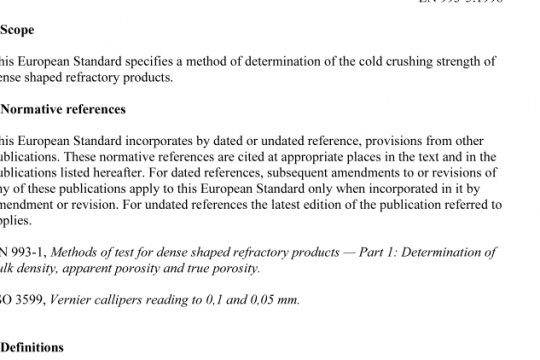BS EN 924 pdf free download
BS EN 924 pdf free download. Adhesives — Solvent-borne and solvent-free adhesives — Determination of flashpoint.
2 Normative references This European Standard incorporates by dated or undated reference, provisions from other publications. These normative references are cited at the appropriate places in the text and the publications are listed hereafter. For dated references, subsequent amendments to or revisions of any of these publications apply to this this European Standard only when incorporated in it by amendment or revision. For undated references the latest edition of the publication referred to applies (including amendments). EN 923:1 998, Adhesives — Terms and definitions EN 1 066, Adhesives — Sampling. EN 1 067, Adhesives — Examination and preparation of samples for testing. 3 Terms and definitions For the purposes of this European Standard, the terms and definitions given in EN 923:1 998 and the following apply: 3.1 flashpoint (closed cup) minimum temperature to which a product, confined in a closed cup, is to be heated for the vapours emitted to ignite momentarily in the presence of a flame, when operating under standardized conditions NOTE In this European Standard, the flashpoint is corrected to an atmospheric pressure of 101 ,3 kPa. 4 Principle The test portion is heated in a suitably designed closed cup by immersing it to the required level in a suitable bath. The temperature of the bath is slowly raised at such a rate that the difference in temperature between the liquid in the bath and the test portion in the cup never exceeds 2°C, and the heating procedure ensures that the temperature of the test portion does not rise more quickly than about 0,5°C in 1 ,5 min (see Note 1 ). During the heating-up period, ignition trials are carried out at intervals of not less than 1 ,5 min (see Note 2). The lowest temperature at which a flash occurs is noted and from this and a duplicate determination the flashpoint of the test product is calculated, corrected to the standard atmospheric pressure of 1 01 , 3 kPa. NOTE 1 To ensure that the test is carried out under approximately equilibrium conditions, a slow rate of heating is recommended because of the low thermal conductivity of some products and also because heat transfer by convection is hindered by the high viscosity of many products. Uniformity of temperature throughout the product under test can be assisted by use of a stirring device, which is not operated during an ignition trial. NOTE 2 A minimum time interval of 1 ,5 min is recommended to ensure that a saturation concentration of vapour in the air space above the test portion is re-established after each ignition trial. 5 Safety Persons using this standard shall be familiar with normal laboratory practice. This standard does not purport to address all safety problems, if any, associated with its use. It is the responsibility of the user to establish safety and health practices and to ensure compliance with any European or national regulatory conditions. If the adhesive is liable to be affected by the cup material, usually copper, an alternative more appropriate cup material, e.g. stainless steel, shall be used. The cup may be fitted with a stirrer to improve uniformity of temperature. If a stirrer originally fitted to the test cup is removed, the aperture in the cover shall be securely plugged before starting the test. Essentially, the test cup shall be fitted with a cover which carries an opening slide and an ignition device which is inserted to a prescribed level into one of the openings in the cover when a test is made. The equipment is such that an ignition trial can be performed by opening the slide, inserting and removing the nozzle of the ignition device, and closing the slide again, within a period of (2,5 ± 0,5) s. A mechanically driven device for opening the slide and applying the ignition device to the air vapour mixture in the cup is permissible and the source of flame for the ignition device may be any suitable flammable gas. Alternatively, an electrical ignition device can be used instead of a flame.BS EN 924 pdf download.




